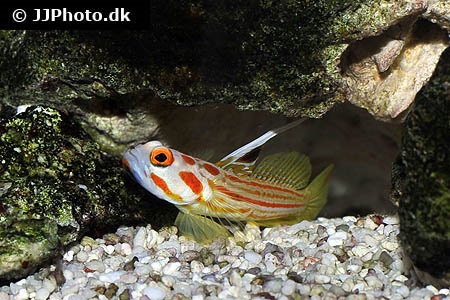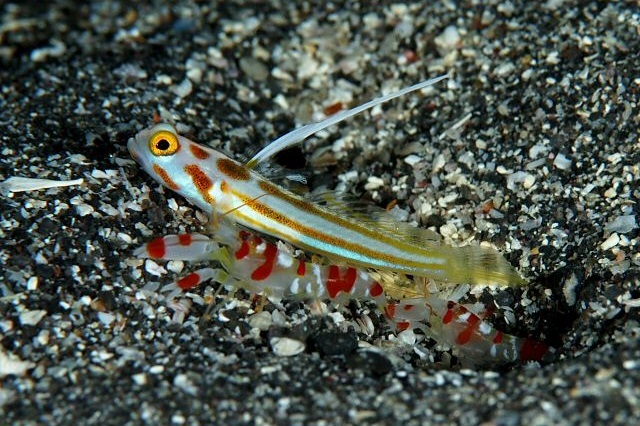Stonogobiops yasha
| Latin name | Stonogobiops yasha |
|---|---|
| Local name | Orange-striped shrimpgoby |
| Family | Gobiidae - Stonogobiops |
| Origin | Australia, Central/West Pacific |
| Max length | 5 cm (2") |
| Minimum volume |
50 l (13 gal) |
|---|---|
| Hardiness |
Hardy |
| Suitable for aquarium |
Suitable for most aquarium |
| Reef safe |
Always reef safe |
| Aggressiveness | Aggressive towards similar species |
| Recommended |
Small crustaceans (Krill, mysis, artemia...) Zooplankton (Cyclops, pods...) |
|---|
This species is known to jump out of open aquaria.
These fish enjoy having their own territory and can be very aggressive towards most approaching fishes.
This species can be kept in a small tank, if it is specifically equipped to meet its needs.
It is recommended however, to keep it in an aquarium which is larger then described above.
This species must be fed with an appropriately varied diet.
This fish requires feeding several times a day, especially when newly added.
When the fish can find its natural food in the aquarium it requires less frequent feeding.
These fish prefer a substrate which allows it to burrow.
A substrate consisting of sand, coral pieces, shells and small pieces of broken up shells is ideal for them to dig holes in.
One can also arrange rocks to enable the fish to create a hole underneath, making certain they are secure and cannot fall over.
There should be space to enable them to make a hole which is at least 1½ inch (3 cm) longer than their own body.
Other animals digging in the sand, can stress this species, if the aquarium is not spacious enough. Be therefore aware of, for example of Wrasses which burrow at night.
This species needs good hiding places, for example, between live rocks.
These fish can have a symbiotic relationship with a Pistol shrimp of the genus Alpheus.
This species is very shy and docile, so one should be careful when keeping it with more aggressive fish.
Gobies (Gobiidae) are generally small fish, which live close to the bottom. Many of the species are fairly hardy and well suited to aquaria. The behaviour of the different kinds of Gobies varies greatly and some can be very interesting.
The most common types of Gobies in aquaria are the following:
Sand eating Gobies (Amblygobius, Koumansetta and Valenciennea)
Sand eaters filter the sand through their mouths and out of their gills.
They are generally bigger than other Gobies, but they are usually peaceful, so size is not a problem.. They can however be aggressive towards their own species.
One must be aware that they can eradicate the micro life in the substrate when the tank is too small. If there is not enough live food in the sand, it can be difficult to ensure the fish stay in good condition, as they require frequent feeding.
They may spread sand across the corals when they eat.
Shrimp Gobies (Amblyeleotris, Cryptocentrus and Stonogbiops)
Shrimp Gobies have a symbiotic relationship with Pistol shrimps, but one must first find out which species can live together.
The shrimp and Goby live together in a small hole in the sand or under a stone where the shrimp maintains the hole, so it will not collapse over time. The Goby helps by looking out for enemies, since the shrimp does not see well in sunlight, as it will have become accustomed its vision to the darkness of the hole.
Neon Gobies (Elacatinus/Gobiosoma)
Thesef Gobies are very small and like the Cleaner Wrasse, it eats parasites off other fish.
These Gobies are easier to keep alive in the aquarium than Cleaner Wrasses, as they can eat a wide range of foods.
Clown Gobies (Gobiodon)
These fish are very small and therefore suitable for small aquariums. Clown Gobies will often hide inbetween the branches of stony corals, like Acropora for example.
They generally eat many types of food, as long as it is small enough.
Francesco Ricciardi. 2013. Aquarium Fish: Sharing a small house without conflicts: the pistol shrimp and the shrimpgoby's life - Advanced Aquarist - (English)
Dave Wolfenden. 2012. Special relationships: Keeping pistol shrimps and gobies - Practical Fishkeeping magazine - (English)
Henry C. Schultz. 2004. "You May Call Me 'Yasha,' King of the Stonogobiops" - Reefkeeping Magazine - (English)
Phil Hunt. 2014. Pistol Shrimps and Gobies: Perfect Partners - Tropical Fish Hobbyist Magazine - (English)
Bob Fenner. Shrimp or Watchman Gobies - Wet Web Media - (English)
Scott W. Michael. Reef Aquarium Fishes: 500+ Essential-to-know Species - TFH Publications / Microcosm Ltd. - (English)
James W. Fatherree. 2011. Aquarium Fish: A Look at the Gobies - Advanced Aquarist - (English)
Bob Fenner. "True" or Combtooth Gobies, the Family Gobiidae - Wet Web Media - (English)





